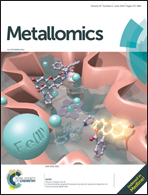Systems impact of zinc chelation by the epipolythiodioxopiperazine dithiol gliotoxin in Aspergillus fumigatus: a new direction in natural product functionality†
Abstract
The non-ribosomal peptide gliotoxin, which autoinduces its own biosynthesis, has potent anti-fungal activity, especially in the combined absence of the gliotoxin oxidoreductase GliT and bis-thiomethyltransferase GtmA. Dithiol gliotoxin (DTG) is a substrate for both of these enzymes. Herein we demonstrate that DTG chelates Zn2+ (m/z 424.94), rapidly chelates Zn2+ from Zn(4-(2-pyridylazo)-resorcinol) (Zn(PAR)2) and also inhibits a Zn2+-dependent alkaline phosphatase (AP). Zn2+ addition rescues AP function following DTG-associated inhibition, and pre-incubation of DTG with Zn2+ completely protects AP activity. Zn2+ (1–50 μM) also significantly relieves the potent gliotoxin-mediated inhibition of Aspergillus fumigatus ΔgliT::ΔgtmA (p < 0.05), which infers in vivo dithiol gliotoxin-mediated sequestration of free Zn2+ or chelation from intracellular metalloenzymes as inhibitory mechanisms. Quantitative proteomic analysis revealed that excess Zn2+ alters the effect of gliotoxin on A. fumigatus ΔgliT, with differential abundance of secondary metabolism-associated proteins in the combinatorial condition. GtmA abundance increased 18.8 fold upon co-addition of gliotoxin and Zn2+ compared to gliotoxin alone, possibly to compensate for disruption to GtmA activity, as seen in in vitro assays. Furthermore, DTG effected significant in vitro aggregation of a number of protein classes, including Zn2+-dependent enzymes, while proteins were protected from aggregation by pre-incubating DTG with Zn2+. We conclude that DTG can act in vivo as a Zn2+ chelator, which can significantly impede A. fumigatus growth in the absence of GliT and GtmA.



 Please wait while we load your content...
Please wait while we load your content...